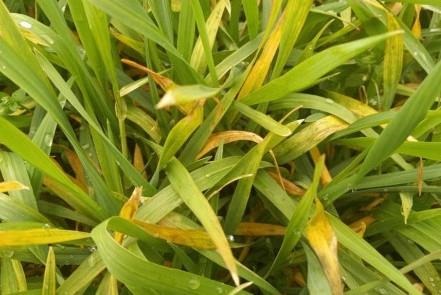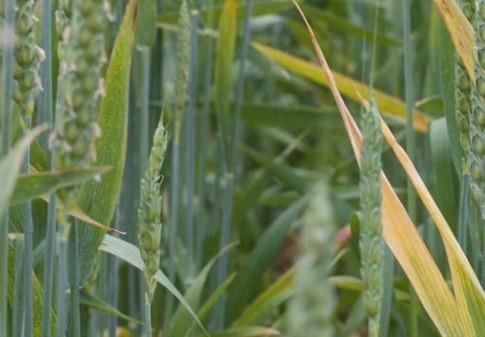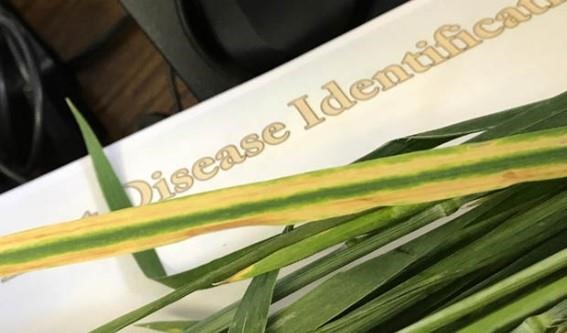By Alyssa and Paul D. Esker
As the weather warms in spring and small grains begin to perk up, we expect to see lush green growth across fields of wheat, barley, and forages like triticale. But what if we also start to see areas of yellowing, stunting, or sparse growth in our fields? Proper diagnosis is key to solving the problem, so here we will talk about some of the possibilities for the cause of these issues, once things like nutrition and spray damage are discarded as options.

Figure 1. A stand of triticale positive for viruses and Clavibacter spp. Photo: J. Rank, Witmer Crop Management
Virus diseases
The most common viral disease of these crops in Pennsylvania and the one that most growers are familiar with remains Barley Yellow Dwarf , which is transmitted by aphid feeding. After overwintering, cereals that were infected in the fall display bright yellow or red discoloration and stunting, usually in patches in the field that reflected by aphids in the fall display bright yellow or red discoloration and stunting, usually in patches in the field that reflects where the pests fed (Figure 2). Preventing this disease depends upon eliminating volunteer cereal plants on your farm and delaying planting. This reduces the opportunity for the pathogen to survive and be spread by aphids to your freshly planted crop.

Figure 2. Barley yellow dwarf on wheat. Photo: K. Borrelli, Penn State.
Other viruses may also be found in small grains in our region (Figure 1). Soilborne wheat mosaic and wheat spindle streak mosaic (SBWMV, WSSMV) can also initiate severe stunting along with yellowing and tip dieback. These viruses are transmitted by a fungus-like soil organism that can survive for several years in affected fields, making management of these diseases challenging. Some varieties with resistance to these viruses are available, so be sure to consider this in your cropping plans.
Diagnosis for these viral diseases requires specialized laboratory testing, so work with your Extension educator to identify the most appropriate options.
Fungal diseases
Septoria tritici blotch is a common fungal leaf spot in our region which tends to appear earlier than other fungal leaf diseases in our region. It may be seen as elongated yellow to brown spots on leaves as early as tillering when conditions mild to cool and wet. Fungicides are effective against this and other fungal leaf spots.
Cephalosporium stripe is caused by a fungus that lives in the soil, and infected plants will begin to show symptoms during spring green-up as a mottled discoloration. As the plant moves into elongation, yellow stripes will begin to appear along the mid-vein of the lowest leaves (Figure 3). This disease can result in depressed growth and dead seed heads. Since this fungus survives in wheat residue, and is favored by areas with poor drainage, rotation and tolerant variety selection is recommended for fields with low lying areas.
Bacterial diseases
A bacterium called Clavibacter michiganense subsp. tessellarius can cause bacterial mosaic of wheat, a relatively uncommon disease characterized by diffuse yellow flecking of the leaves. This bacterium persists in crop residue, but may also be seedborne. To avoid this disease, starting with certified seed is recommended.
For help diagnosing your problematic small grain stands, work with your Extension educator to determine if it's time to send some samples to the Penn State Plant Disease Clinic.

Figure 3. Cephalosporium stripe on wheat. Photo: D. Collamer, Growmark FS.
Source : psu.edu